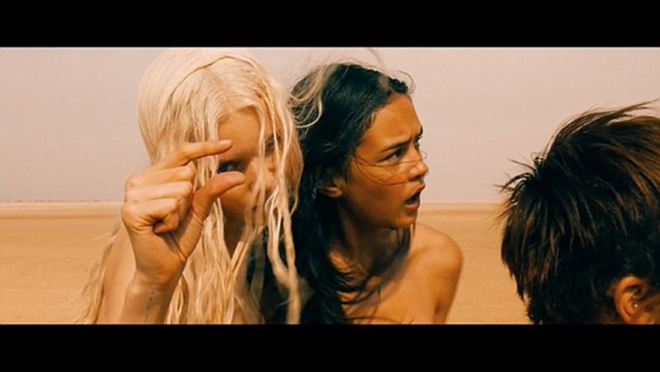If you’ve stood anywhere near an internet-connected computer for the past week or so, you may have heard it muttering a steady stream of praise for the new Mad Max: Fury Road. The good news is, the internet buzz is not wrong. The bad news is, if you’ve literally heard your computer talking to you, you might have more to worry about than the quality of a new movie.
Fury Road is awesome for at least a dozen reasons. The car chases and action sequences, the vast majority of them pulled off without CGI, are both visceral in the moment, and more awe-inspiring when you think about them afterwards. Those guys swinging on forty-foot counterbalanced poles while tearing down the salt flats at 50 miles an hour? They actually did that.
But the technical wizardry is backed up by an equally mind-bending level of imagination. The world of the earlier Mad Max movies was weird, but this time around it feels both more fully realized, and more grounded. We see much more of George Miller’s imagined society — hydroponic farms, increasingly complex infrastructure, multiple warring tribes and settlements rather than just good vs. bad.
We also get a better sense of the people who live in that world. Much of that is thanks to the tiny touches of characterization given to a dozen or so of the Warboys, the grunts in big baddie Immortan Joe’s wheeled army. In the previous Max films, the antagonists were facelessly malevolent, but here we see them in their warrens, talking amongst themselves, showing that they actually have internal lives, individual personalities, portions of themselves that haven’t been washed away by their grinding circumstances or the cultic ideology that holds them together.
It’s a particularly notable move in light of the wave of so-called “men’s rights activists” who have slagged the movie for marginalizing the title character. It’s hard to disagree with their premise – Tom Hardy’s Max is a ride-along on a quest driven by Charlize Theron’s Imperator Furiosa. And that’s largely because, unlike Mel Gibson’s stoic, eminently competent Max, this Max is overtly traumatized, shaky, and, at least at first blush, not entirely trustworthy.
It’s a feminist message on multiple levels — and one that the “men’s rights activists” (I’m going to keep that in quotes, because, come on) should actually applaud. The original thesis of men’s rights, outlined in books by Warren Farrell, was that men were just as forcefully slotted into their social roles as women. Fury Road gives its men – whether the newly-fragile Max or Nicholas Hoult’s questioning Warboy Nux – the ability to break out of the archetypes prepared for them, yielding both responsibility and aggression to the women who are, in the given moment, more ready for it. And that's real feminism - giving everyone the freedom to figure out who they are, and where they belong.
All of that will continue to be unpacked and debated in the coming months and years — but what will keep us going back to Fury Road to do the unpacking is the amazing cinematography, strange imagined world, and appropriately furious action (It occurs to me – is the title meant as a dig at the Vin Diesel franchise? Because this monster blows those other car-chase movies out of the water).
Don’t miss this one while it’s in theaters — it’ll never look or feel half as impressive even on your widescreen. If you can stomach it, try the 3D — it works shockingly well when it’s not being overpowered by CGI gimmickry. And I might even (and I can’t believe I’m saying this) point you in the direction of those ridiculous D-Box vibrating seats. I sat behind a row of them and even the secondary vibrations gave the experience a little boost.


